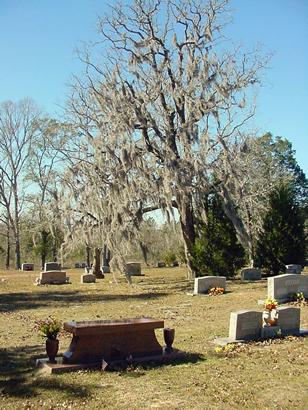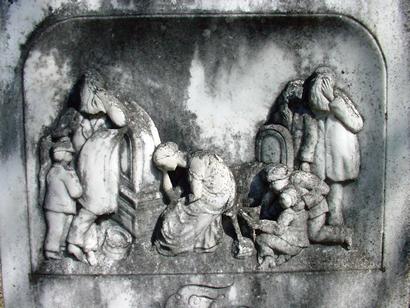|
|
GHOSTS OF OLD
WAVERLY
and
The Old Waverly Cemetery
An East Texas
Tale of Two Hills
By John Troesser
Illustrated with Waverly Cemetery Tombstone Art |
It’s
easy to reach New Waverly since
it’s on the state map just off Interstate Highway 45 about 55 miles
north of Houston. Much
harder to find is Old Waverly,
just a few miles east but not on the state map. With no town center
and only a church and cemetery
left (and those spaced far apart) it’s a challenge to find without
a local guide.
The town of Waverly once straddled the county line, but even that
fact is little help. The difference between Old
Waverly and New Waverly was,
of course, the arrival of the railroad in the 1880s. It’s a very familiar
story in Texas. One town gets the railroad,
and the other town gets forgotten. Adding insult to injury, the left-behind
town is sometimes branded with the word “old.”
Back when there was a single Waverly, the town was thriving, with
a youthful population freshly arrived from Alabama, Georgia and other
southern states. An “institute of higher learning” was established
and the town seemed to have limitless horizons. But along came the
Civil War and Waverly’s antebellum hopes turned into sacrifice, immense
hardship and finally “death by railroad bypass.”
Old Waverly’s fade into oblivion
may be short of tragic elements, but two
separate stories were enough to have it included in the late Ed
Sayer’s Ghosts of Texas. When one considers the cottage industry
that spooks and spirits have become in recent years, it’s an accomplishment
to be included as one of the fifty-odd stories in what is considered
to be the first volume written on Texas
Ghosts.
The sites of the stories
are several miles apart in what remains today of the dense forest
that was laboriously pushed back by slave labor to plant cotton.
|
Soldier’s
Hill
A knoll in the vicinity was once named Soldier’s Hill. It was (relative)
high ground that was once occupied by Union troops although the author
doesn’t mention if it was held during the war or in that unhappy period
called Reconstruction. For the sake of the story, it hardly matters.
Part of the land patrolled by the troops from their base camp of Soldier’s
Hill included a desolate cabin – one of the first built by settlers.
The incident that occurred at the cabin has few details. One version
has it that a young girl was killed there and three Federal troops
may have been involved. Guilty or not, the one agreed on fact is that
the three were murdered – perhaps in retaliation for the crime. Fearful
of incurring the wrath of the main contingent, the killers hurriedly
buried the soldiers beneath the cabin floor.
Ever since, anyone who attempted to live in the cabin was driven out
by strange nocturnal sounds. A fiddle was sometimes heard playing,
and men were heard coughing. On some occasions the sounds of a screaming
girl were heard. The landowners built another house, although they
let the older building stand. The cabin went unoccupied but its reputation
grew.
If additional proof of a haunting was needed, it was provided by animals
who balked at entering the now-deteriorating building. According to
Sayer’s account, cats and dogs “would stand in the rain” rather than
cross the cabin’s threshold.
One local newspaperwoman who attempted to spend the night in the cabin
in the 1970s quitted her project early on. Her contribution to the
legend was seeing a strange fog around the site, even while a stiff
breeze was blowing.
In respect of the owner’s privacy, the location of the site has been
kept a secret. |
Sentry Hill
The second haunted site near Old
Waverly was described as being just northeast of what had been
the town. This spirit seems to be single and is thought to be either
a Union soldier who perhaps took his duty a tad too seriously and
never left his post – or a sawmill operator who perhaps took his work
not seriously enough and left behind his head.
No one has fully described any detailed sightings, but there have
been many “auditory” encounters – nearly all of them occurring at
night. Sayers reports a local man who is drawn to the site and on
one occasion brought a witness. He and his skeptical friend were exploring
the site when they heard something running toward them through the
underbrush. The friend was amused and as his partner ran toward their
car, he (laughing) yelled: “it can stop the car’s engine!” When his
friend got in the car and indeed, it didn’t start – the friend stopped
laughing and together they jump-started the car, thankful to be able
to escape whatever “it” was.
The story had an anticlimactic end with Sayers’ investigation coming
to a halt when his guide canceled on him. He then attempted to go
it alone but was bogged down in mud up to his wheel wells.
These stories are presented here not for their quality, details, or
the goose-flesh factor, but mostly to provide text for their accompanying
Waverly Cemetery photographs. |
 |
Historical
Marker: (Walker County)
Waverly Cemetery
This cemetery is
situated on the land originally purchased in 1853 by Mary M. Lewis,
James E. Scott, Laura A. Scott, and Milly D. Scott. The first recorded
burial was that of John Andrew Jackson (1822-1855), a pioneer settler
of Waverly. Three gravestones
dated 1852 indicate reinterments rather than earlier burials. Hamlin
F. Lewis, John Elliot Scott, and Robert Lindsey Scott left Alabama
for Texas but fell victim to cholera in 1852 and were buried along
the way. Relatives of the men had their remains placed in this site
in 1859.
In 1857 Waverly Institute purchased 200 acres of land which included
the burial ground. Through the efforts of Henry M. Elmore (1816-1879),
President of Waverly Institute Board of Trustees, twelve acres were
officially set aside for cemetery use in 1873.
The town of Waverly was a cultural,
educational, and religious center before the Civil War. When New
Waverly was founded on the railroad in the 1880s, Waverly
declined, but its cemetery remains in use. The burial ground has always
been associated with the pioneer settlers of Waverly.
In 1965 descendants of the settlers formed a cemetery association
to maintain the site. |
 |
Waverly Cemetery
tombstone
TE photo, 2006 |
Waverly Cemetery
historical marker
TE photo, 2006 |
|
|
 Texas
Gulf Coast
Texas
Gulf Coast East
Texas
East
Texas Central
Texas North
Central
Texas North Central
Texas South
Central
Texas South Texas
Panhandle
Texas
Panhandle South
Texas
South
Texas Texas
Hill Country
Texas
Hill Country West
Texas
West
Texas Texas
Ghost Towns
Texas
Ghost Towns Texas
Counties
Texas
Counties